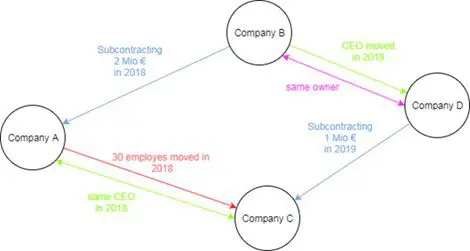On behalf of the Federal Ministry of Finance, the Mobile Knowledge Lab is researching multigraphs as an approach to predicting fiscal risks and improving the accuracy of regulatory audits.
In the field of fraud prevention, predictive analytics methods represent an essential and established approach. A subarea of these procedures deals with methods of social network analysis (SNA), which are based on graph theory. In this process, a so-called graph data structure is digitally created in which real observed relationships between actors are replicated. Networks consisting of different connections and connection types can be modeled in so-called multigraphs.
In this context, the Mobile Knowledge Lab is researching new methods to make multigraphs useful for fiscal risk assessment by modeling complex economic reality relationships.

The figure shows examples of both financial and personnel links between four companies. Based on the investigation of known fraud cases in such networks, recurring fraud patterns could be identified.
Predictive analytics is used in a wide variety of areas and industries, such as telecommunications, banking or in the fight against disinformation. The Federal Ministry of Finance also relies on these methods. For example, information on large-scale employee migrations, contract awards or shareholding structures can be used to model links between companies. The goal here is to use predictions to increase the hit rate in audit procedures and thus ensure compliance with all tax regulations without holding up business operators with unnecessary audits. Hard-to-detect carousel transactions, a common form of tax fraud in the EU, can also be an application area for Predictive Multigraph Analytics.
Project and MoKnow Lab Studio manager Bernhard Göschlberger sees great potential after the first year of research: “We were able to show that the modeled networks are homophilic with respect to the target variables. This means that they have the necessary properties for good predictions.”
In the coming year, the research project will focus primarily on the temporal component of such relationships. Random relationships with fraudulent companies are to be evaluated differently in predictions than long-standing exchanges.

